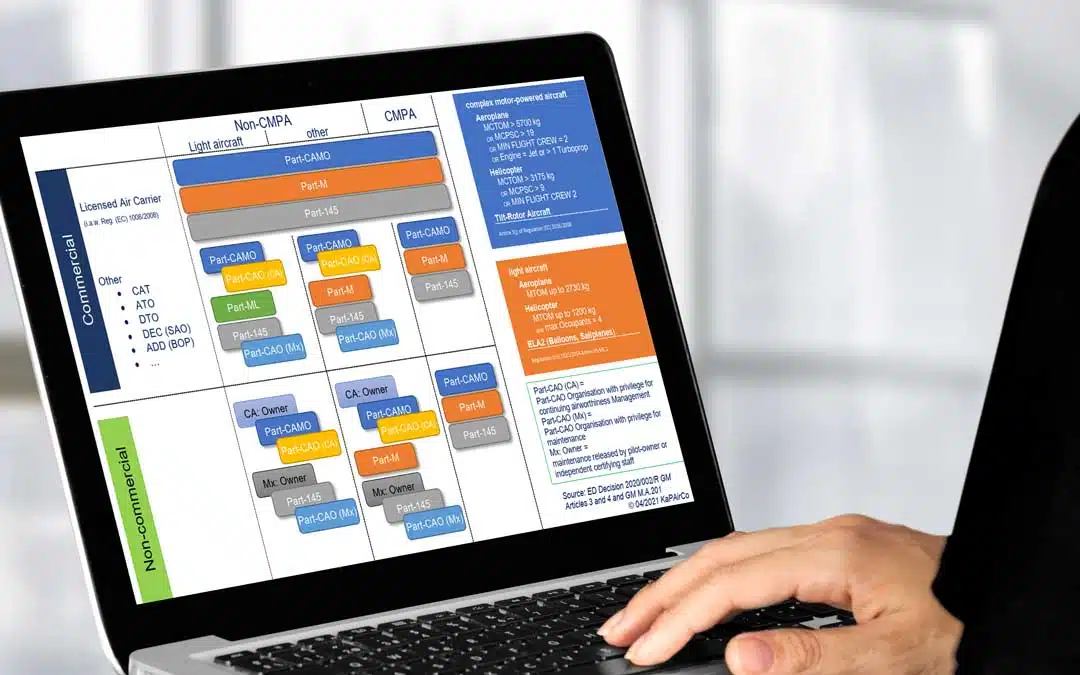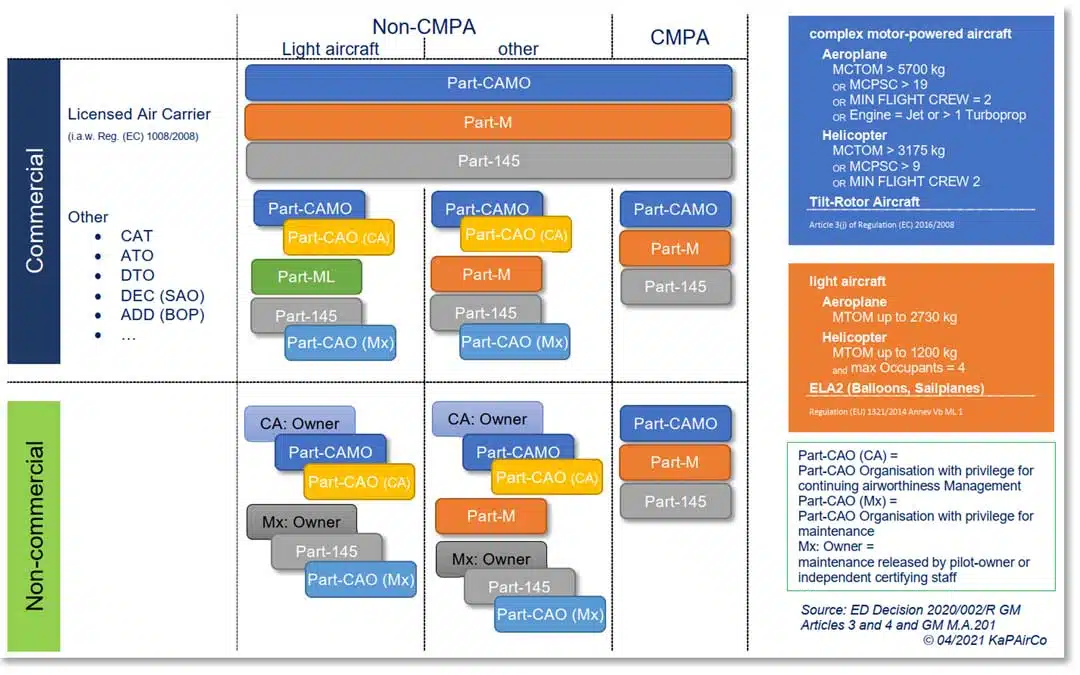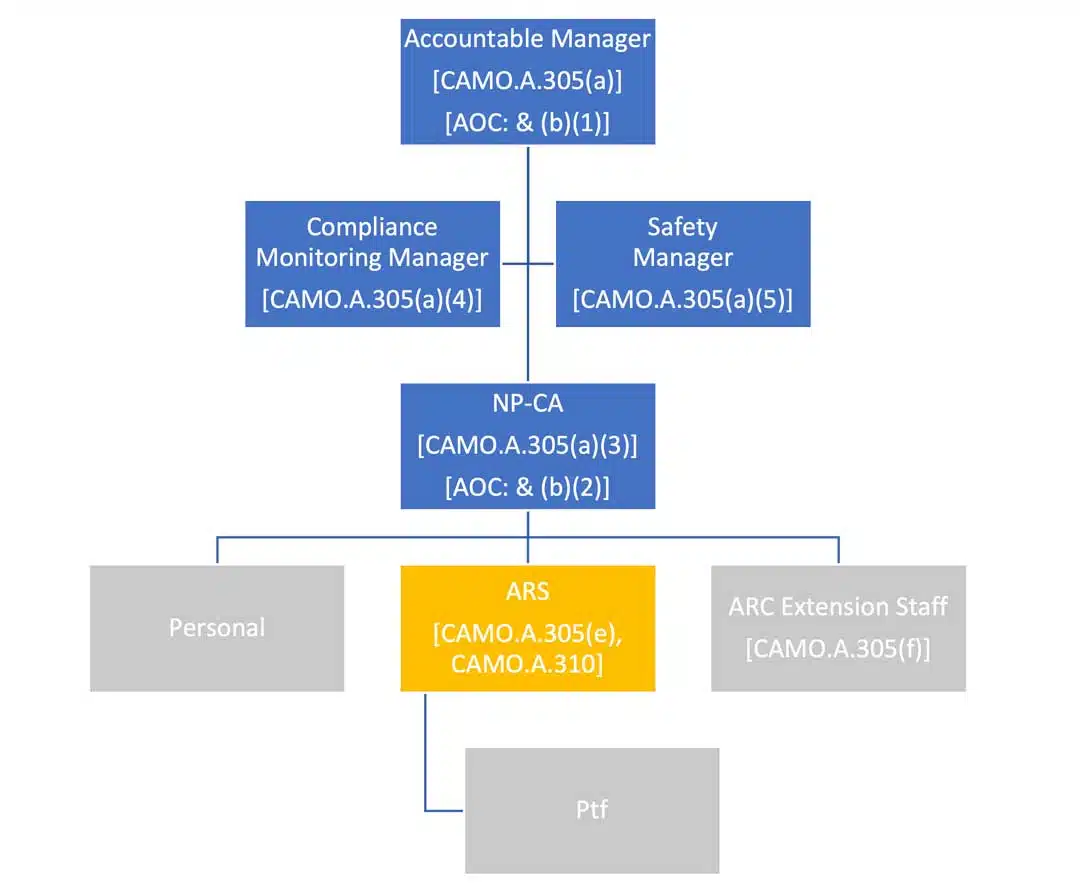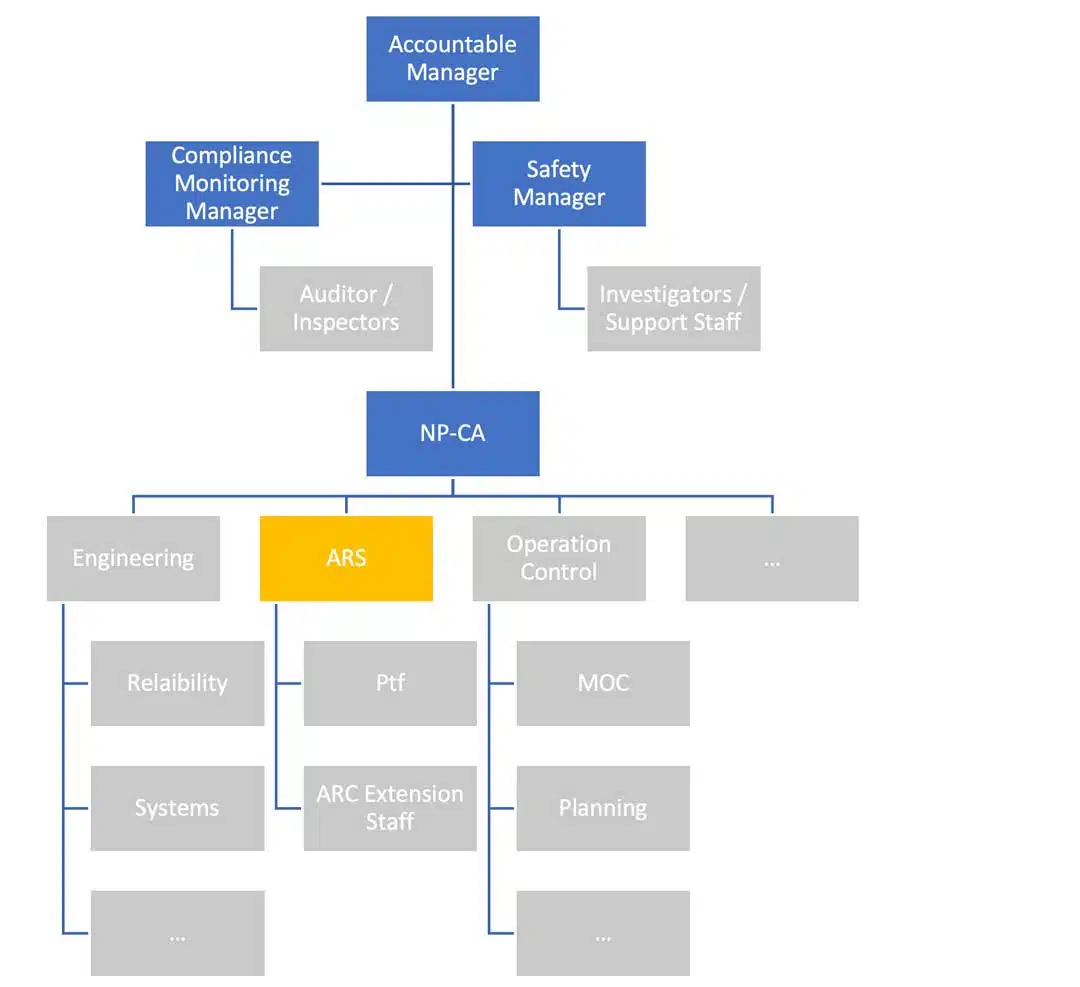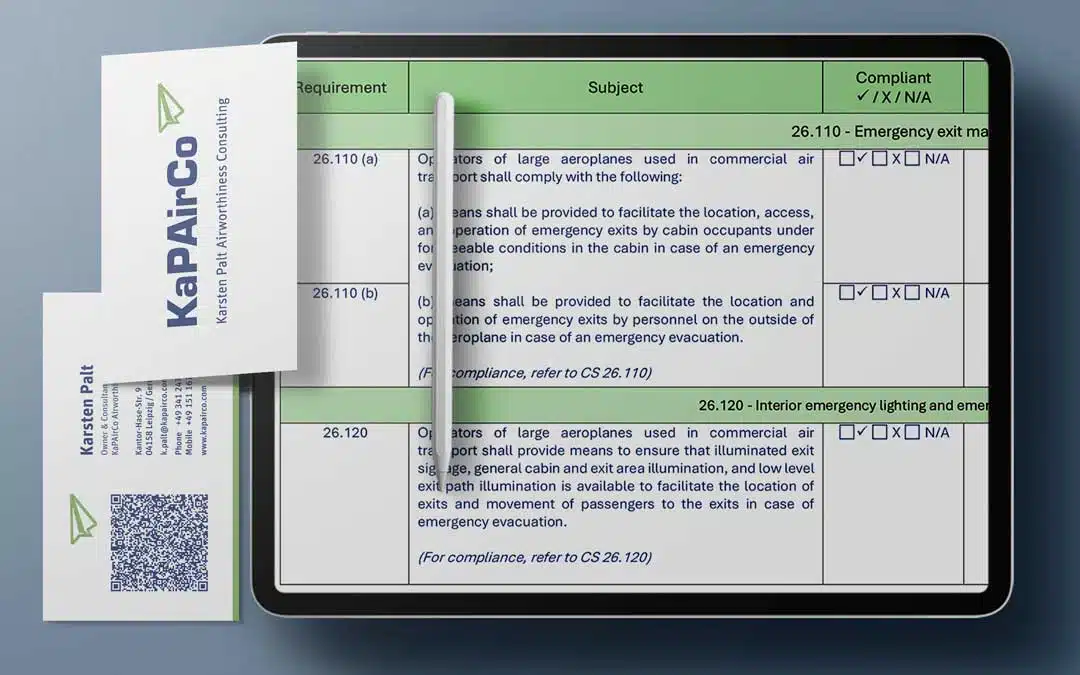This article is meant to explain you briefly what a CAMO is and what it does. If you are already familiar with the EASA aviation rules this might be irrelevant for you. If you have specific questions for CAMO or other airworthiness topics, don’t hesitate to contact KaPAirCo for advice.
What is a CAMO?
CAMO is the abbreviation of the Continuing Airworthiness Management Organisation. This is either a self-sustaining company or a part of a larger aviation company like an airline holding an Air Operator Certificate (AOC).
The CAMO is defined and required by several European civil aviation requirements. Other regulatory frameworks outside Europe do know the CAMO as well. One example is Australia (CASR Part 42). In this article we will focus to the European CAMO.
The continuing airworthiness is managed by the CAMO which means that several tasks mandated by the aviation regulations are fulfilled by the CAMO.
By complying with all the task, the aircraft is considered airworthy, but how is this Airworthiness defined?
Airworthiness of an aircraft is the fitness of an aircraft for flight in all conditions for which it has been designed, and to which it may therefore be exposed. This means that during the whole lifecycle of the aircraft, for all types of operations and in all environments, the structure of the aircraft must remain unchanged.
To that end, every aircraft must first be certified. The certification process, also known as initial airworthiness, is carried out in the EU by the European Union Aviation Safety Agency (EASA) on behalf of the Member States. The common technical requirements and administrative procedures for the airworthiness and environmental certification of aircraft are set out in Regulation (EU) No 748/2012.
During the aircraft’s lifetime, ‘continuing airworthiness activities’ are carried out to ensure continuous fitness for flight. The common technical requirements and administrative procedures for the continuing airworthiness are set out in Regulation (EU) No 1321/2014.
Website of the European Commission / Mobility and Transport, retrieved on 2022-12-28
Does a CAMO perform maintenance of aircraft?
No, CAMO does not perform any maintenance. A CAMO does manage the continuing airworthiness with performing a wide bunch of different tasks. One task is to have maintenance contracts in place to order any due maintenance at an approved maintenance organisation. The aircraft maintenance is either performed by organisation approved acc. to Part-145 or acc. to Part-CAO for light aircraft not used by licensed air carriers.
Who is managing the continuing airworthiness and who is performing the maintenance of aircraft?
Please refer to chart above to understand the responsibility for continuing airworthiness management and for aircraft maintenance.
All aircraft, even a small Cessna 172, if operated by a licensed air carrier, require a CAMO and need to follow Part-CAMO and Part‑M and maintenance must be performed by maintenance organizations approved by Part-145. This is also required for all complex motor-powered-aircraft, regardless of in commercial or non-commercial operation.
The continuing airworthiness and partly the maintenance of private (non-commercial) light aircraft can be managed by either the owner or by a CAMO or by a CAO (Combined Airworthiness Organisation).
The responsibility depends otherwise on the type of operation and type of aircraft as seen above.
What are the tasks of a CAMO?
The continuing airworthiness tasks include
- Ensuring that operational and emergency equipment fitted is correctly installed and serviceable or clearly identified as unserviceable
- Ensuring that the airworthiness certificate is valid
- Provide pre-flight inspections guidance to maintenance organisation and flight crews
- Manage rectification of defects and damages
- Planning of maintenance according to the maintenance program (AMP) and ordering the performance of maintenance
- Ensure accomplishment of maintenance i.a.w. AMP including review of the performed work
- Analysis of effectiveness of the AMP
- Accomplishment of Airworthiness Directives (AD), Operational Directive, continuing airworthiness requirement by EASA, measures by competent authority
- Accomplishment of modifications and repairs with (Part-21J) approved data
- Delivering of Mass & Balance Statement
- Ensure performance of maintenance check flights
- Continuous analysis of the effectiveness of defect control system
- Assessment of non-mandatory information (e.g. Service Bulletins)
- Occurrence reporting to the aviation authority
- Having an own maintenance organisation or having maintenance contract(s) in place
- …
Depending on aircraft type and the type and complexity of operation several additional tasks apply, like engine trend monitoring, airplane health monitoring, health and usage monitoring for helicopters, engine condition monitoring, oil monitoring, only to mention a few.
The CAMO must develop an aircraft maintenance program (AMP) for every aircraft. A fleet program can be acceptable if every requirement for every aircraft is taken into account and is identified as applicable. There are several requirements taken into consideration for this program. Also, the planned utilization of the aircraft including the environmental conditions (for example dusty/sandy environment) need to be considered. The AMP is subject to verification and approval by the aviation authority.
The AMP includes inspections of the aircraft and its components including overhaul requirements of components. It includes also due times of life-limited parts (LLP) and time-controlled components. Depending on the type of managed aircraft it can be required to develop and maintain a Reliability Program as well.
The CAMO needs to ensure that all maintenance is performed according to that approved maintenance program. They need to proof this from time to time to the aviation authority and possible to leasing companies or others.
The CAMO needs to establish and maintain an appropriate aircraft continuing airworthiness record system in compliance with M.A.305 and CAMO.A.220. All records need to be organized according to the approved procedures and kept for a defined record keeping time. Availability of digital data, location of systems and backups are regulated as well.
The CAMO must also ensure that it receives correct release certificates after any maintenance performed for aircraft (aircraft certificate of release to service) and components (EASA Form 1 or other).
Airworthiness Review Certificate
The CAMO must ensure that the airworthiness certificate remains valid. This is proven by another certificate, the Airworthiness Review Certificate (ARC, EASA Form 15). Such an ARC has a validity of 1 year and can be renewed two times. That means it has a maximum validity of 3 years. The certificate can be issued by the competent authority or issued or extended (renewed) by an approved CAMO. The ARC will be issued after a successful performed Airworthiness Review. This is an inspection of the aircraft, the so-called physical survey together with a review of the records of the aircraft. It will be verified that no differences can be found between the records and the aircraft.
Approval by Aviation Authority, Privileges and Scope of Work
When all requirements are fulfilled and after performance of a pre-audit the organization can apply for an approval with the responsible civil aviation authority (competent authority).
The basic approval allows the CAMO to manage the aircraft type acc. to the issued approval certificate (Scope of Work). The CAMO could subcontract several tasks to other companies, but this is subject to approval by the authority and, when granted, also shown on the certificate.
The CAMO can have additional privileges, with the easiest one the performance of the extension of the Airworthiness Review Certificate (ARC). If the CAMO is located in one of the member states of the EASA, the CAMO could have the privilege to perform the Airworthiness Review and as an add-on the privilege to issue a permit to fly.
The CAMO approval remains valid as long as all requirements remain fulfilled.
What are the regulatory requirements for a CAMO?
The following EU regulations are relevant for the Work of a CAMO:
- Regulation (EU) 2018/1139 — Basic Regulation
- Commission Regulation (EC) No 1321/2014
- Annex I — Part‑M & Annex Vb — Part-ML (Continuing Airworthiness)
- Annex Vc — Part-CAMO (Organisation Requirements)
- Commission Regulation (EU) 2015/640 – Part-26 (& CS-26)
- Regulation (EU) No 748/2012 – Part-21 (Initial Airworthiness)
- EASA Acceptable Means of Compliance (AMC) and Guidance Material (GM).
- EASA Certification Specifications (e.g. CS-25, CS-29)
- National requirement
- And other
What are the requirements for personnel of a CAMO?
Every CAMO needs at least an Accountable Manager, a Nominated Person for Continuing Airworthiness (NP-CA), a Compliance Monitoring Manager and a Safety Manager, as shown on the following chart.
The personnel for the ARC Extension are only required if the CAMO wants to use the privilege. The ARS – Airworthiness Review Staff is required to apply for the extended privilege to perform airworthiness reviews and to issue the airworthiness review certificate. The same ARS could also be approved to issue the permit to fly.
The so-called nominated persons of the CAMO are subject to acceptance by the aviation authority. In most cases an exam is written (e.g. multiple-choice test) and a personnel interview performed.
AMC1 CAMO.A.305© specifies several personnel requirements like the basic technical education like holding an engineering degree to an adequate technician qualification, practical experience, and trainings, knowledge of the relevant aircraft types and knowledge of the applicable regulations. In short, you need an appropriate qualification and at least 5 years’ experience to fulfill such a position. The EU member states can even require higher and or additional requirements.
The CAMO personnel need to receive initial and refresher trainings and a documented periodic competency assessment of the CAMO personnel is required.
How is a CAMO organized?
An organizational manual is required (by CAMO.A.300) to lay out the organisation and processes of the CAMO. This manual is called CAME, which is the abbreviation of Continuing Airworthiness Management Exposition. A management system is required (ref. to CAMO.A.200) with safety management including safety reporting and compliance monitoring management. The CAME is subject to an approval from the relevant civil aviation authority. Amendments of the CAME will be subject to either a prior-approval process or a non-prior-approval process. That means that certain changes to the organisation or the processes need the approval from the competent authority whereas other changes can be approved internally by the company.
The organisation of the CAMO is depending on the size and responsibilities of the CAMO and the size, complexity and operational needs of the respective operator/airline or customer(s).
A larger CAMO could be organized as follows. You can easily identify the required positions and the optional personnel (in relation to aviation law) to manage the whole workload.
Who is checking the work of the CAMO?
All tasks and the records of the CAMO are subject to internal auditing and to oversight by the competent authority, which includes on-site auditing as well.
2022-12-28, Karsten Palt, KaPAirCo Airworthiness Consulting
